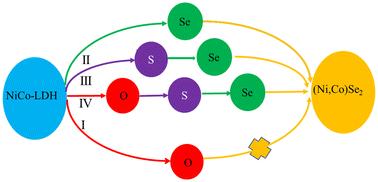Using a sequential synthesis approach to fabricate (Ni,Co)Se2 electrodes for high-performance supercapacitors
IF 3.3
3区 化学
Q2 CHEMISTRY, INORGANIC & NUCLEAR
引用次数: 0
Abstract
The synthesis of bimetallic selenides, derived from bimetallic oxide precursors, has garnered considerable attention for their potential in supercapacitor applications. However, the challenge of promoting their selenization degree from bimetallic oxide precursors to optimize electrochemical performance remains a significant hurdle. In this work, (Ni,Co)Se2 electrode materials with a rose-petal-like morphology have been fabricated through a sequential synthesis method from a NiCo-LDH precursor and their supercapacitive performance has been systematically evaluated. The results show that the as-synthesized (Ni,Co)Se2 delivers a specific capacitance of 1565 F g−1 at 1 A g−1, which is better than those of other nickel–cobalt bimetallic selenides. Additionally, the as-synthesized (Ni,Co)Se2 exhibits excellent rate capability, retaining 97.7% capacitance at 10 A g−1. Additionally, at a current density of 20 A g−1, (Ni,Co)Se2 retained 87.8% of its capacity after 5000 cycles. Furthermore, the supercapacitor constructed from (Ni,Co)Se2 and activated carbon exhibits a remarkable energy density of 44.44 Wh kg−1 at a power density of 867.78 W kg–1. This superior electrochemical performance benefits from the sequential synthesis strategy that not only significantly enhances the product's selenization degree, thereby boosting its electrochemical properties, but also maintains the inherent rose-petal-like morphology, ensuring optimal mass transport efficiency. Furthermore, a possible explanation for the improvement of the selenization degree is also proposed.

采用顺序合成方法制备高性能超级电容器用(Ni,Co)Se2电极
由双金属氧化物前体衍生的双金属硒化物的合成因其在超级电容器中的应用潜力而引起了相当大的关注。然而,提高双金属氧化物前驱体的硒化程度以优化电化学性能仍然是一个重大的挑战。本文采用NiCo-LDH前驱体序贯合成方法制备了玫瑰花瓣状的(Ni,Co)Se2电极材料,并对其超电容性能进行了系统评价。结果表明,合成的(Ni,Co)Se2在1 a g−1时的比电容为1565 F g−1,优于其他镍钴双金属硒化物。此外,合成的(Ni,Co)Se2表现出优异的倍率性能,在10 A g−1时保持97.7%的电容。此外,在20 a g−1的电流密度下,(Ni,Co)Se2在5000次循环后仍能保持87.8%的容量。此外,由(Ni,Co)Se2和活性炭构建的超级电容器在功率密度为867.78 W kg - 1时,能量密度为44.44 Wh kg - 1。这种优异的电化学性能得益于顺序合成策略,该策略不仅显著提高了产物的硒化程度,从而提高了其电化学性能,而且保持了其固有的玫瑰花瓣状形态,确保了最佳的质量传递效率。此外,还对硒化程度的提高提出了可能的解释。
本文章由计算机程序翻译,如有差异,请以英文原文为准。
求助全文
约1分钟内获得全文
求助全文
来源期刊

Dalton Transactions
化学-无机化学与核化学
CiteScore
6.60
自引率
7.50%
发文量
1832
审稿时长
1.5 months
期刊介绍:
Dalton Transactions is a journal for all areas of inorganic chemistry, which encompasses the organometallic, bioinorganic and materials chemistry of the elements, with applications including synthesis, catalysis, energy conversion/storage, electrical devices and medicine. Dalton Transactions welcomes high-quality, original submissions in all of these areas and more, where the advancement of knowledge in inorganic chemistry is significant.
 求助内容:
求助内容: 应助结果提醒方式:
应助结果提醒方式:


